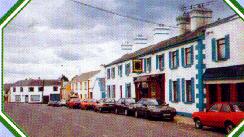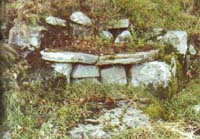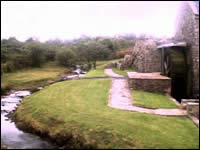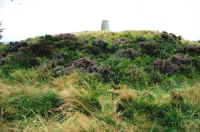|

The town of Drumlish is a large picturesque village in north County Longford. It is close to the Cavan and Leitrim Borders and is 11 kilometers from Longford Town. Drumlish Parish extends from the eastern side of the parish of Clonguish to a short distance beyond the village of Ballinamuck and has a population of 274. The area is predominantly rural with lakes and unspoilt landscape.
Several major and well-known events have given Drumlish a prominent place in recent Irish history, as noted below. But those born and raised in Drumlish and its environs never forget its great natural beauty. In witness whereof, click on "Hear 'My Native Town Drumlish'" above, and listen to that lovely song by Dermot Hegerty.
Until the middle of the 18th century, Drumlish formed part of the parish of Killoe. It was first known as "The Parish of Monaduff", because the church stood in the townland so named about half way between Ballinamuck and Drumlish. It was not until 1822 that the name was changed from Monaduff to Drumlish.
Drumlish has many reminders of pre-historic past which carries the mind back to the dim and distant ages of the Bronze Age, or even to Neolithic Times.
At Melkagh, there are a number of Pillar Stones which in Pagan Times (about 2500 BC) were erected as memorials to the dead. The name Creaghlaghta (Crith-Leachta) would suggest an abundance of prehistoric monuments. Remains of a crannog is still to be seen in Fardromin Lake, and also a ringfort in Drumbad. At Cloonaugh (Cluain Each), "The Meadow of the Steeds", a large flagstone with many emblems on it is yet refusing to reveal its secrets.

Melkagh is one of the three known portal dolmans in the County although perhaps not the most spectacular of the three. There are a number of stone pillars which date back to pre-Christian times. Usually in those Pagan days, they were erected as memorials to the dead. In some cases, however, they were used as a medium through which worship was paid to the departed dead. During penal times mass was offered in the forth in Melkagh. Melkagh is situated 2.5km north of Drumlish on the main Drumlish/Cloone road.
Drumlish earned its place in history due to the participation of its people in the Land War, 12-14 January 1881. On the 11th if January in 1881, a confrontation between the members and adherents of the Irish National Land League, and the Royal Irish Constabulary took place in the parish of Drumlish. Lord Granard sent a bailiff , supported by his retinue and a large detachment of the constabulary, to serve eviction notices on those tenants in and around Drumlish who were unable to pay their rents.. The people of Drumlish and Ballinamuck, on hearing the unwelcome news, made a hasty exit from their slumbers and prepared to resist the process server. Already, three hundred families had been evicted from within a radius of three miles around Drumlish.
However, this time the people of Drumlish were not willing to give in lightly and it wasn't long before things came to a head. The people were called by the church bell and armed with guns, scythes, reaping hooks and pitchforks to meet openly with the Lord of Granard, his process-server, bailiffs and the red coats in Drumlish. Under the leadership of Father Tom Conefrey, an open battle was averted.
The local people eventually won and were allowed to reduce rents. Father Conefrey is remembered, even to this day, in Drumlish and surrounding areas for his bravery and courage. This famous episode of the Land War which took place in Drumlish is documented in the book The Land War in Drumlish by Fr. P. Conefrey. For more on this seminal event, see below under Longford, "THE LAND WAR".
POINTS OF INTEREST IN DRUMLISH
BOGS, FLORA and FAUNA. Drumlish has a unique environment with its unspoilt rural landscape and the natural beauty of its bogs. Peatlands are ecosystems comprising 95% water. They support combinations of plants and animals that do not exist in other habitats. Plants which can be seen include sphagnum, sundrew and bladderwort. Birds likely to be spotted include the kestrel, the red grouse and the snipe. Many bog plants were traditionally used in folk remedies and new uses are still being investigated.
LOUGH SALACH. Set in a remote and unspoiled landscape, Lough Salach is a haven of tranquility. The lake teems with pike, perch, bream, roach and is situated approximately three miles from Drumlish.

The OLD CORN MILL at Drumlish is situated along the main Longford/Cavan Road, almost beneath the shadow of Cairn Hill. It has been in the Rogers family for nearly two centuries and did a flourishing business up to the 1950s. It served a wide area for the milling of oats into oatmeal and also corn-crushing. During the famine of 1846/1847 the oats crop helped many to survive and as a result Drumlish did not suffer as badly as other areas. In recent years, the exterior of the Mill and its surround has been restored by Drumlish Enterprise Group under the Community Employment Scheme and has enhanced the entrance to the village.
CAIRN HILL. Also referred to as Corn Hill (recognizing the rye -"corn"- which was grown there) Cairn Hill stands on the northern side of the village and lovely views can be enjoyed from its slopes. From the summit lakes and rivers stretching over many neighboring counties can be seen. There are several written accounts of cairns, dolmens and passage graves on the hill, but the exact positions are not known. These structures date back to 2500 BC. This would indicate that this area was inhabited at the time of the building of the pyramids in Egypt
Cairn Hill is the famous Sliabh Cairbe in Annaly, Barony of Granard. It is said that Farbuide Fer Benn who revenged the killing of his mother by Medbh (Queen Maeve of Cruchan) is buried there. The story is that he killed Queen Maeve at her bathing place on Inchcleraun Island in Lough Ree using a slingshot from the shore a mile away. The location of the burial site on Cairn Hill is not known, but perhaps it is in one of the two cairns found there. The hill lies north of Longford Town, about halfway between Drumlish and Ballinalee. It is about 300 meters above sea level, and commands a panoramic view from its summit. A booster station with a 100 meters high mast for television transmission by Radio Telefis Eireann is now, unfortunately, situated on top of the hill.
Kilmahon Graveyard. At Kilmahon there is an ancient cemetery and some faint traces of an early church or ceall' - the cell of a hermit. This hermit was St Muadan or St Mahon and reference is made to him in the ancient manuscript relating to St Colmcille. In fact he is a contemporary of Colmcille and so lived in the 6th century. The Book of Leinster speaks of Mahon of Kilmahon and gives the 12th May as his feast day. The Martyrology of Donegal gives the 6th March as his date of birth.

The Cairns of Corn Hill. There is an access road to the top of Corn Hill so the sites can be accessed by car. From Drumlish take the road to Ballinalee, 4 km from Drumlish make a left turn. Corn Hill should be on your left, follow the road until you come to a T-junction turn left and then left again. This will have you at the back of Corn Hill and the access road is the second lane on the left. This site is comprised of two cairns. As you can see from the picture above these cairns are nothing more than moss covered mounds. The peak stone is placed on the top of the first cairn at a height of 278m above sea level. The second cairn is located just south-east of the first and is not as predominant.
COUNTY LONGFORD A focal point of the northern midlands where the provinces of Leinster, Ulster and Connaught converge, Longford, where history and literature, tragedy and triumph are all woven together, takes its name from the ancient stronghold of the O'Farrell family (Long Fort - Fort of the O'Farrells).
Bordered to the west by the majestic River Shannon, Longford is a county of rolling plains and picturesque stretches of water, of quiet farmlands and brown bog, with occasional low hills and pleasant views of lake and river. It is bordered by Counties Leitrim, Cavan, Westmeath and Roscommon - being separated from County Roscommon on the west by the River Shannon and its lakes. The highest point of the county, Cairn Hill, is only 279m high, but from atop the summit glorious views in all directions are afforded. Farbuide Fer Benn, renowned in Irish mythology for revenging the death of his mother who was killed by Queen Maeve, is supposedly buried here. The county offers angling, hunting and shooting, and should interest the lover of literature in the association with Oliver Goldsmith, Maria Edgeworth, John Casey and Padraic Colum. The general aspect of the county of Longford, viewed from a height on a fine summers day, is inviting and pleasing. Taking one's stand on the summit of Lisduff, and looking due north, the visitor will see a deep rolling plain stretch out before him for a distance of perhaps ten kms. bounded by historic Cairn Hill. On the right and left of this hill the country slopes down to a fertile level plain, beautifully wooded, through which the Camlin flows to the Shannon. In a north eastern direction the rising country about Granard looms up in a succession of hazy hillocks, with bright green pastures and dark green plantations. Looking to the east is the view of Ardagh's woody heights, beyond which lies a lovely stretch of fertile country.
The present county came into being under the Tudors in 1547, based largely on a region which had previously been known after two of its most prominent rulers, Queen Teffia(pre 800 AD) and King Annaly (post 800 AD). From the eleventh century the region has been ruled by the descendants of Ferghall ('the valiant one'), a hero of the Battle of Clontarf (1014 AD), who had marched westwards and forcibly taken control of the area.
It was in Longford that some of the fiercest fighting of the 1798 rebellion took place when the 'Year of the French' came to a bloody end at Ballinamuck, where Edgeworth and Goldsmith were inspired to write several of the most acclaimed works of the English language and where General Sean MacEoin, 'the Blacksmith of Ballinalee' conducted the War of Independence with cunning and bravery during the early 1920's. Longford's motto emblazoned across its county crest declares it to be Daingean agus Dilis - Strong and Loyal; without doubt it has lived up to its self-set standards and profoundly influenced the Ireland of today.
DRUMLISH/BALLINAMUCH IN HISTORY
The name Ballinamuck, Baile Atha na Muice, recalls the black pig tradition associated with the boundary of Ulster. It ran from Lough Boderg towards Granard on to the Blackwater, and the Boyle, which would suggest that part of the North Longford area was in the province of Ulster at one time. In the time of St. Patrick, it was in the kingdom of Meath, later still, with the coming of the Comnaice, in Connaught and since the time of James I, in Leinster. At Kilmahon, there are traces of an early church or Ceall, the cell of a hermit, St. Muadan (St. Mahon). He didn't live alone, but actually had a large contingent of loyal worshipers.
Then to Ballinamuck came the year of the French, 1798. On the morning of the 8th September, General Humbert and his army of 800 French and 1,500 Irish were on their way from Cloone to Granard. He reached Ballinamuck pursued by an advance guard of General Lake's under the command of Colonel Crawford. He made contact with the rear guard of the French at Kiltycreevagh. About 200 men under Sarrazin lay down their arms immediately. Humbert had gone onto Ballinamuck and made ready for battle. He and 400 of the French together with a large number of the Irish moved up the hill of Shanmullagh , the remainder, the Battalion of Irish Pipemen under General Blake along with the French Grenadiers, under Captain Jobit were posted along the road. They were expecting their own rear guard but instead, the British arrived. The French opened fire, but soon found themselves facing squadrons of cavalry After 15 mins., Jobit was outflanked, surrendered with about 200 men. Blake getting free withdrew to a new position at Gaigue.
Humbert was all that was left against the British. Lake attacked the hill several times, but was driven back by the Irish Pikemen. When the hill was surrounded on all sides, Humbert surrendered with all the French without making any terms for the Irish. 500 of the insurgents fell on the battle field, the remainder were pursued into the bogs and slain without mercy. At Gaigue, the final episode was finished. Blake with Gunner McGee and Casey made a heroic stand all to no avail. Blake and McGee were taken and hanged. This memorable epoch was recently commemorated with the bi-centenary celebrations in this North Longford village.
The police fortress (now the '98 Hall), was built in Ballinamuck in 1830, with 2 towers. It was ringed by the Barracks at Fardromin, Kilevaha, Leganomer, Aughadowry and Drumlish. All stood on elevated sites so the police RIC could communicate with each other by means of waving a lantern if attacked. The first murder took place in 1835. Peter Harte who had been ostracized for voting Tory was killed at Ballinamuck. John Brock, the first Protestant put into the estate by Lord Lorton at Creaghlaghta was murdered. Arthur Cathcart who lived in Fardromin was attacked on a number of occasions and finally shot near his own house. William Morrisson was appointed Baliff after Cathcart's death, but he was choked in Ginty's pub in Drumlish. Hugh Moorhead was choked beside a clamp of turf on the bog, later, Michael Kenny was hanged for Moorhead's murder. The most tragic scene of the war was the burning of the village with 40 houses in April of 1839, at the request of Lord Lorton. He admitted afterwards that the burning was promoted by his anger at the savage barbarism on his estate. During the next 20 years, the area suffered the same fate as the rest of the country - Famine
THE LAND WAR
The next major historical event which occurred in the parish was "The Land War". On the 12th January 1881 the process-server arrived in Drumlish to serve ejectment notices on a number of Lord Granard's tenants around the village. The Drumlish and Ballinamuck and neighboring branches of the Land League knew beforehand that he was coming, and they organized resistance. Lord Granard sent his bailiff to point out the houses. When they got near Drumlish they were met by a large crowd, and after some aggressive demonstrations, they got as far as the barracks. They then set out for the house of Thomas Rogers in Derawley to serve the first process. Every field around the house was literally packed with men, and the women too formed no inconsiderable portion of the vast multitudes. A very tense and dangerous situation developed, because the Land League and their supporters were determined that the process would not be served, and the authorities were equally determined that it would. In the end the process was not served. The situation was potentially ugly, and that it did not become bloody was largely due to the restraining presence and influence of Fr. Tom Conerfry. But the situation was intolerable from the point of view of the authorities, and they returned in greater numbers and with greater force on the 13th, and again on the 14th. They failed to serve the processes and the attempt was abandoned.
In 1919, Longford was organized on a battalion basis. The Drumlish/Ballinamuck area was covered by the 5th battalion. On the 6th January 1920 with Sean MacEoin and James Connolly attacked the barracks in Drumlish. Later the barracks in Ballinamuck was attacked. On the 19th June, 1921, Tommy Kelleher was shot dead by 10 Auxiliaries. His death was only about three weeks before the truce that ended the war. A Celtic Cross known as "The Kelleher Monument" commemorates this tragic event.
|